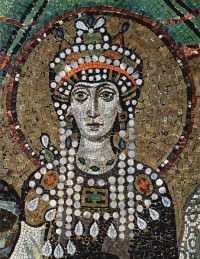Procopius’ Portrayal of Theodora in the Secret History: ‘Her Charity was Universal’
Nadine Elizabeth Korte
Hirundo, Vol.3 (2004)
Abstract
There are many sources for the reign of Justinian (527-565 CE), such as those written by John Malalas, Evagrius Scholasticus, John Lydus and John of Ephesus; there are even the emperor’s own legal works. Despite this, it is Procopius of Caesarea (c. 500 – c. 565) and his three works, the History of the Wars, the Buildings and the Secret History, which are inescapable. Procopius’ importance is due to his unique first-hand knowledge; he accompanied Justinian’s star general Belisarius on campaigns against both the Persians and the West. Yet the use of Procopius as a source is not without its difficulties. What is remarkable is the difference in the descriptions these three works give of Justinian and Theodora. Throughout the Wars, Procopius compliments Justinian for his expulsion of the barbarians. In the Buildings, Procopius describes how Justinian took a period of disorder and “not only made it greater in extent, but also much more illustrious.” The SH, on the other hand, has Procopius describing Justinian as the veritable anti-Christ, who along with his wife, was a demon incarnate responsible for all of society’s problems:
“I, like most of my contemporaries, never once felt that these two were human beings: they were a pair of blood-thirsty demons…[f]or they plotted together to find the easiest and swiftest means of destroying all races of men and all their works, assumed human shape, became man-demons, and in this way convulsed the whole world.
Many authors seem content to relegate the SH to a mere footnote or to a parting remark, instead of trying to determine why Procopius would write the SH in such a vehement tone. Perhaps more unsettling than this change of opinion towards the emperor, is Procopius’ treatment of Theodora. Justinian’s wife Theodora is described in graphic sexual detail as a loose and immoral woman. As Judith Herrin jokingly states: “It is almost as if one of the most respected historians of our time published hard-core pornography under a pseudonym. Perhaps some do?”
Procopius’ Portrayal of Theodora in the Secret History: ‘Her Charity was Universal’
Nadine Elizabeth Korte
Hirundo, Vol.3 (2004)
Abstract
There are many sources for the reign of Justinian (527-565 CE), such as those written by John Malalas, Evagrius Scholasticus, John Lydus and John of Ephesus; there are even the emperor’s own legal works. Despite this, it is Procopius of Caesarea (c. 500 – c. 565) and his three works, the History of the Wars, the Buildings and the Secret History, which are inescapable. Procopius’ importance is due to his unique first-hand knowledge; he accompanied Justinian’s star general Belisarius on campaigns against both the Persians and the West. Yet the use of Procopius as a source is not without its difficulties. What is remarkable is the difference in the descriptions these three works give of Justinian and Theodora. Throughout the Wars, Procopius compliments Justinian for his expulsion of the barbarians. In the Buildings, Procopius describes how Justinian took a period of disorder and “not only made it greater in extent, but also much more illustrious.” The SH, on the other hand, has Procopius describing Justinian as the veritable anti-Christ, who along with his wife, was a demon incarnate responsible for all of society’s problems:
“I, like most of my contemporaries, never once felt that these two were human beings: they were a pair of blood-thirsty demons…[f]or they plotted together to find the easiest and swiftest means of destroying all races of men and all their works, assumed human shape, became man-demons, and in this way convulsed the whole world.
Many authors seem content to relegate the SH to a mere footnote or to a parting remark, instead of trying to determine why Procopius would write the SH in such a vehement tone. Perhaps more unsettling than this change of opinion towards the emperor, is Procopius’ treatment of Theodora. Justinian’s wife Theodora is described in graphic sexual detail as a loose and immoral woman. As Judith Herrin jokingly states: “It is almost as if one of the most respected historians of our time published hard-core pornography under a pseudonym. Perhaps some do?”
Click here to read this article from Hirundo
Subscribe to Medievalverse
Related Posts